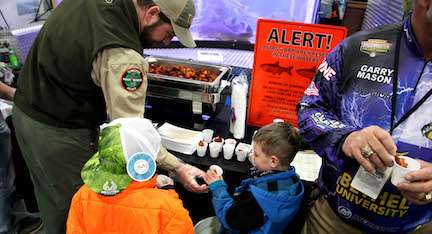
It’s not every day people line up to eat fish from a plate with two orange ALERT warning signs posted on either side. In fact the fare raised eyebrows Saturday at the Bassmaster Classic Outdoors Expo presented by DICK’S Sporting Goods.
Then again, it’s not every day people line up to eat Asian carp.
The Tennessee Wildlife Resources Agency brought in a pile of fried silver carp Saturday and people literally ate it up.
Diane Peters, visiting from Marietta Georgia, was like many who picked up a piece of the fried fish, popped it in her mouth, raised her eyebrows a bit, smiled and said, “It’s actually really good, it’s just too bad it’s not where it’s supposed to be.”
Indeed that was the whole point of offering the tasty tidbits between those signs, which usually are posted on lakes and rivers to warn people the carp are present. Asian carp are a growing invasive species issue and the Tennessee and Kentucky wildlife agencies are encouraging people to make use of them to help keep down the population. The fried samples and recipe handouts were just a bit of encouragement for growth in a commercial market for Asian carp as dinner fare and to encourage anglers to keep those carp as well.
“If you’re out boating down the lake enjoying a Saturday and one jumps in your boat, take it home and eat it, don’t put it back in the lake,” Assistant Chief of Fisheries Jason Henegar said.
That people actually liked the fish was not a surprise to David Roddy, invasive species biologist for the agency. At a recent event in Nashville he brought in 25 pounds each of catfish and Asian carp and gave it to people in a blind taste test and the carp won the day.
“Seventy-five percent chose the carp as the better tasting fish,” he said. “And in Nashville people know catfish so that’s almost a biased sample.”
Henegar said he’s had Asian carp fried, smoke, baked and on kabobs on the barbecue and it’s been good every time.
“It’s a good white-flesh fish, not quite as flaky as crappie or catfish, it’s more dense like cod, but there is no fishy flavor, it goes well with whatever flavoring you want to use, or you can just roll it in flour and put it in some 350-degree oil and fry it up and it’s great,” he said.
The fish Saturday came from North American Caviar, a processor in Paris, Tennessee, he said. The agency also sometimes uses Fin Gourmet Foods out of Paducah, Kentucky for such events.
“We purchase them as fillets and all the bones are removed,” he said. “For an event it would take too much manpower to fillet all those fish, and it’s better to work with the businesses and support the market.”
Filleting a carp is where the rub comes in for some anglers who have never tried to clean a fish with so many Y-bones. Henegar said there are plenty of videos online that show how it’s done, but the crux of the cleaning process is to fillet like you would any fish and trim away the red meat. The next step is to cut down the center of the fillet lengthwise and then down along the Y-bones, lengthwise, on those top and bottom halves so you end up with four strips of boneless meat out of each fillet.
“The Y-bones are heavier than what you find in something like a salmon so it’s pretty easy to run your knife along and feel them,” he said. “You’ll have a bunch of nice boneless strips of meat when you’re done.”
The de-boning process is a little harder with smaller fish, he said. Commercial fishermen target fish between 7 and 20 pounds for that reason.
The agency has its work cut out encouraging this interest in carp commercially as well because the fish are hard to catch. So hard in fact that the agency had to incentivize commercial fishermen by helping the market set a minimum 20 cents per pound price.
“They are the most net-wise fish I’ve ever seen,” Henegar said. “They will sense the net and turn around or they will jump over it.”
Fishermen sometimes string double nets so they catch them in the second net as they jump over the first. Not only are they net-wise, but the fish travel in large schools and fishermen have to go out and find them, shallow or deep, wherever they might happen to be on any given day.
“They are not an easy fish to catch,” he said.
The state has allocated gas tax money to fund the Asian Carp Harvest Incentive Program, which guarantees that 20-cent per pound purchase price by reimbursing buyers 10 cents per pound for every pound they purchase from fishermen at the 20-cent price or higher. Fishermen get an incentive, too, with the agency giving them additional net material when they reach certain poundage levels in their harvest.
“We’ve set a goal to hit 4 million pounds, for both Tennessee and Kentucky, for 2019 and we’re well on our way already to meeting those goals so the market really is growing,” he said.
The samples and recipes for fried or smoked carp handed out at the Expo Saturday were just a small part of the effort, but folks like Cherie Jordan of Marion County Tennessee are a start.
“I like the taste,” she said. “They need to get rid of those things so I guess this is a good way to do it.”

